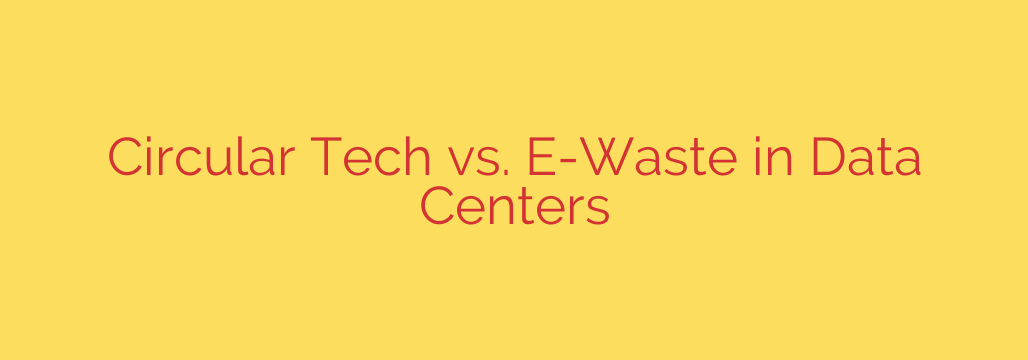
Tackling Data Center E-Waste: Why the Circular Economy is the Future of IT
Our increasingly digital world runs on a massive physical infrastructure: the data center. While we enjoy the benefits of cloud computing, streaming, and instant connectivity, there’s a growing environmental cost that often goes unseen—the staggering amount of electronic waste (e-waste) generated by the IT industry.
Data centers are at the heart of this issue. The traditional approach to IT hardware has long been a linear one: take, make, use, and dispose. Servers, storage arrays, and networking equipment are typically refreshed every three to five years to keep up with performance demands. This relentless cycle contributes to millions of tons of e-waste annually, burdening landfills with hazardous materials and wasting valuable resources.
However, a more intelligent and sustainable approach is gaining momentum: the circular economy. This model challenges the disposable mindset by focusing on maximizing the value of hardware throughout its entire lifecycle.
The Problem with the Linear “Take-Make-Dispose” Model
The conventional IT lifecycle is fundamentally wasteful. When a server is deemed “end-of-life” by a large enterprise, it’s often perfectly functional for less demanding applications. Yet, it’s frequently decommissioned and sent for disposal.
This process has severe consequences:
- Environmental Damage: E-waste contains toxic substances like lead, mercury, and cadmium that can leach into soil and water if not handled properly.
- Resource Depletion: Manufacturing new equipment requires mining finite raw materials, including precious metals like gold, silver, and palladium, consuming immense energy and water.
- Economic Loss: Discarding functional hardware is like throwing away money. The residual value of the equipment is lost, and the cost of disposal adds to the total cost of ownership.
The Circular Economy: A Smarter Framework for IT Assets
The circular economy offers a powerful alternative by redesigning the lifecycle of technology. Instead of a straight line to the landfill, it creates a continuous loop of value. The core principles are simple but transformative: reduce, reuse, repair, refurbish, and recycle.
For data centers, this means a strategic shift in how assets are managed. The goal is no longer just to procure and deploy, but to extend the life and value of every component.
Here’s how it works in practice:
- Extend Lifecycles: Instead of automatically retiring servers after a fixed period, organizations can assess their viability for secondary roles. A high-performance server from a financial institution might be ideal for a small business or a development lab.
- Embrace Refurbishment: A robust secondary market exists for enterprise-grade hardware. Certified refurbished equipment can offer significant cost savings—often 40-70% less than new—without a major compromise on performance for many workloads. This reduces the demand for new manufacturing.
- Prioritize Repair and Upgrades: When a component fails, the first instinct should be to repair or upgrade, not replace the entire unit. Swapping out RAM, storage drives, or power supplies can breathe new life into an aging server.
- Responsible Recycling: When a piece of equipment truly reaches the end of its usable life, it must be responsibly recycled. This means partnering with certified IT Asset Disposition (ITAD) vendors who can safely extract valuable materials and dispose of hazardous components in an environmentally sound manner.
The Tangible Benefits of a Circular Approach
Adopting a circular model isn’t just an environmental initiative; it’s a sound business strategy with clear advantages.
Significant Cost Reduction: The most immediate benefit is financial. Reducing procurement costs by purchasing refurbished hardware and recovering value by selling decommissioned assets directly impacts the bottom line. It lowers the Total Cost of Ownership (TCO) for IT infrastructure.
Enhanced Supply Chain Resilience: The recent global chip shortages highlighted the fragility of the technology supply chain. A circular model reduces dependency on new manufacturing, providing an alternative source of high-quality hardware when new equipment is unavailable or subject to long lead times.
Measurable Sustainability Gains: By extending the life of hardware, organizations drastically reduce their carbon footprint, conserve natural resources, and divert tons of e-waste from landfills. This is a critical component of any corporate Environmental, Social, and Governance (ESG) program.
Actionable Steps for a Secure, Circular Data Center
Transitioning to a circular model requires a shift in mindset and policy. Here are key steps to get started:
- Develop a Comprehensive ITAD Policy: Don’t let asset disposition be an afterthought. Create a formal policy that prioritizes reuse and refurbishment before recycling.
- Partner with Certified Vendors: Work with ITAD partners who hold certifications like R2 (Responsible Recycling) or e-Stewards. These credentials ensure they adhere to the highest standards for data security and environmental protection.
- Prioritize Data Security Above All: The biggest concern with reusing hardware is data security. Ensure your ITAD partner provides certified data destruction services compliant with standards like NIST 800-88. This process guarantees that all data is irretrievably wiped before an asset is resold or recycled.
- Rethink Your Refresh Cycles: Challenge the assumption that all hardware must be replaced every three years. Analyze workloads and identify where older, reliable equipment can continue to provide value.
The move toward a circular economy is more than a trend; it’s an essential evolution for the technology industry. By treating hardware as a durable asset rather than a disposable commodity, data centers can become more economically efficient, resilient, and environmentally responsible.
Source: https://datacenterpost.com/how-circular-tech-can-outsmart-e-waste-in-the-booming-data-center-market/








